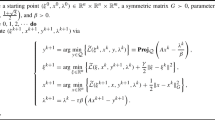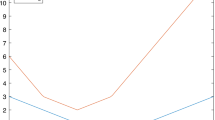Abstract
This paper analyzes the iteration-complexity of a generalized alternating direction method of multipliers (G-ADMM) for solving separable linearly constrained convex optimization problems. This ADMM variant, first proposed by Bertsekas and Eckstein, introduces a relaxation parameter \(\alpha \) into the second ADMM subproblem in order to improve its computational performance. It is shown that, for a given tolerance \(\varepsilon >0\), the G-ADMM with \(\alpha \in (0, 2)\) provides, in at most \({\mathcal {O}}(1/\varepsilon ^2)\) iterations, an approximate solution of the Lagrangian system associated to the optimization problem under consideration. It is further demonstrated that, in at most \({\mathcal {O}}(1/\varepsilon )\) iterations, an approximate solution of the Lagrangian system can be obtained by means of an ergodic sequence associated to a sequence generated by the G-ADMM with \(\alpha \in (0, 2]\). Our approach consists of interpreting the G-ADMM as an instance of a hybrid proximal extragradient framework with some special properties. Some preliminary numerical experiments are reported in order to confirm that the use of \(\alpha >1\) can lead to a better numerical performance than \(\alpha =1\) (which corresponds to the standard ADMM).
Similar content being viewed by others
Notes
An operator \(T:\mathbb {R}^s\rightrightarrows \mathbb {R}^s\) is said to be monotone if \( \langle {z-z'},{s-s'}\rangle \ge 0\), for every \(z,z'\in \mathbb {R}^s,\)\(s\in T(z)\) and \(s'\in T(z')\). Moreover, T is maximal monotone if it is monotone and, additionally, if S is a monotone operator such that \(T(z)\subset S(z)\) for every \(z\in \mathbb {R}^s\) then \(T=S\).
References
Bertsekas, D.P.: Constrained Optimization and Lagrange Multiplier Methods. Academic Press, New York (1982)
Boyd, S., Parikh, N., Chu, E., Peleato, B., Eckstein, J.: Distributed optimization and statistical learning via the alternating direction method of multipliers. Found. Trends Mach. Learn. 3(1), 1–122 (2011)
Chambolle, A., Pock, T.: A first-order primal-dual algorithm for convex problems with applications to imaging. J. Math. Imaging Vis. 40(1), 120–145 (2011)
Corman, E., Yuan, X.: A generalized proximal point algorithm and its convergence rate. SIAM J. Optim. 24(4), 1614–1638 (2014)
Cui, Y., Li, X., Sun, D., Toh, K.C.: On the convergence properties of a majorized ADMM for linearly constrained convex optimization problems with coupled objective functions. J. Optim. Theory Appl. 169(3), 1013–1041 (2016)
Deng, W., Yin, W.: On the global and linear convergence of the generalized alternating direction method of multipliers. J. Sci. Comput. 66(3), 889–916 (2016)
Eckstein, J.: Parallel alternating direction multiplier decomposition of convex programs. J. Optim. Theory Appl. 80(1), 39–62 (1994)
Eckstein, J.: Some saddle-function splitting methods for convex programming. Optim. Methods Softw. 4(1), 75–83 (1994)
Eckstein, J., Bertsekas, D.P.: On the Douglas–Rachford splitting method and the proximal point algorithm for maximal monotone operators. Math. Progr. 55(3 Ser. A), 293–318 (1992)
Fang, E.X., He, B., Liu, H., Yuan, X.: Generalized alternating direction method of multipliers: new theoretical insights and applications. Math. Prog. Comput. 7(2), 149–187 (2015)
Gabay, D., Mercier, B.: A dual algorithm for the solution of nonlinear variational problems via finite element approximation. Comput. Math. Appl. 2, 17–40 (1976)
Glowinski, R.: Numerical Methods for Nonlinear Variational Problems. Springer Series in Computational Physics. Springer, Berlin (1984)
Glowinski, R., Marroco, A.: Sur l’approximation, par éléments finis d’ordre un, et la résolution, par penalisation-dualité, d’une classe de problèmes de Dirichlet non linéaires. RAIRO Anal. Numér. 9, 41–76 (1975)
Gonçalves, M.L.N., Alves, M.M., Melo, J.G.: Pointwise and ergodic convergence rates of a variable metric proximal alternating direction method of multipliers. J. Optim. Theory Appl. 177(2), 448–478 (2018)
Gonçalves, M.L.N., Melo, J.G., Monteiro, R.D.C.: Extending the ergodic convergence rate of the proximal ADMM. arXiv preprint arXiv:1611.02903 (2016)
Gonçalves, M.L.N., Melo, J.G., Monteiro, R.D.C.: Improved pointwise iteration-complexity of a regularized ADMM and of a regularized non-euclidean HPE framework. SIAM J. Optim. 27(1), 379–407 (2017)
Gu, Y., Jiang, B., Deren, H.: A semi-proximal-based strictly contractive Peaceman–Rachford splitting method. arXiv preprint arXiv:1506.02221 (2015)
Hager, W.W., Yashtini, M., Zhang, H.: An \({O}(1/k)\) convergence rate for the variable stepsize Bregman operator splitting algorithm. SIAM J. Numer. Anal. 54(3), 1535–1556 (2016)
He, B., Yuan, X.: On the \(\cal{O}(1/n)\) convergence rate of the Douglas–Rachford alternating direction method. SIAM J. Numer. Anal. 50(2), 700–709 (2012)
He, B., Yuan, X.: On non-ergodic convergence rate of Douglas–Rachford alternating direction method of multipliers. Numer. Math. 130(3), 567–577 (2015)
Lin, T., Ma, S., Zhang, S.: An extragradient-based alternating direction method for convex minimization. Found. Comput. Math. 17(1), 17–35 (2017)
Liu, J., Duan, Y., Sun, M.: A symmetric version of the generalized alternating direction method of multipliers for two-block separable convex programming. J. Inequal. Appl. 2017(1), 129 (2017)
Monteiro, R.D.C., Svaiter, B.F.: On the complexity of the hybrid proximal extragradient method for the iterates and the ergodic mean. SIAM J. Optim. 20(6), 2755–2787 (2010)
Monteiro, R.D.C., Svaiter, B.F.: Iteration-complexity of block-decomposition algorithms and the alternating direction method of multipliers. SIAM J. Optim. 23(1), 475–507 (2013)
Nishihara, R., Lessard, L., Recht, B., Packard, A., Jordan, M.I.: A general analysis of the convergence of ADMM. arXiv preprint arXiv:1502.02009 (2015)
Ouyang, Y., Chen, Y., Lan, G., Pasiliao Jr., E.: An accelerated linearized alternating direction method of multipliers. SIAM J. Imaging Sci. 8(1), 644–681 (2015)
Solodov, M.V., Svaiter, B.F.: A hybrid approximate extragradient-proximal point algorithm using the enlargement of a maximal monotone operator. Set-Valued Anal. 7(4), 323–345 (1999)
Sun, H.: Analysis of fully preconditioned ADMM with relaxation in Hilbert spaces. arXiv preprint arXiv:1611.04801 (2016)
Tao, M., Yuan, X.: On the optimal linear convergence rate of a generalized proximal point algorithm. J. Sci. Comput. 74(2), 826–850 (2018)
Tibshirani, R.: Regression shrinkage and selection via the lasso. J. R. Stat. Soc. B 58(1), 267–288 (1996)
Tibshirani, R.J.: The lasso problem and uniqueness. Electron. J. Stat. 7, 1456–1490 (2013)
Wang, X., Yuan, X.: The linearized alternating direction method of multipliers for Dantzig selector. SIAM J. Sci. Comput. 34(5), 2792–2811 (2012)
Yang, J., Yuan, X.: Linearized augmented Lagrangian and alternating direction methods for nuclear norm minimization. Math. Comput. 82(281), 301–329 (2013)
Author information
Authors and Affiliations
Corresponding author
Additional information
The work of these authors was supported in part by CNPq Grants 302666/2017-6, 406975/2016-7 and CAPES.
Rights and permissions
About this article
Cite this article
Adona, V.A., Gonçalves, M.L.N. & Melo, J.G. Iteration-complexity analysis of a generalized alternating direction method of multipliers. J Glob Optim 73, 331–348 (2019). https://doi.org/10.1007/s10898-018-0697-z
Received:
Accepted:
Published:
Issue Date:
DOI: https://doi.org/10.1007/s10898-018-0697-z
Keywords
- Generalized alternating direction method of multipliers
- Hybrid extragradient method
- Convex program
- Pointwise iteration-complexity
- Ergodic iteration-complexity




